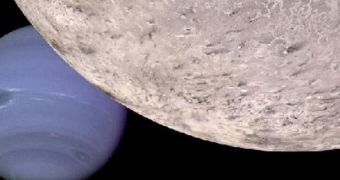Scientists at NASA have just released a new, computer-generated image showing Neptune (in blue) and one of its moons, Triton. According to the people who created the image, this is the landscape a spacecraft would see when approaching the ice giant from behind its natural satellite.
Interestingly, the image also includes Triton's polar cap, which is famous for being heavily eroded by both strong winds and intense sublimation processes. The erosion is visible at the bottom of the moon, as shown in this image.
In the upper right corner, scientists included a depiction of a special type of terrain featuring large numbers of cryovolcanoes. Unlike conventional volcanoes, these ones shoot ice and other types of matter into the air, not lava and ash.
The latest flyby ever made of Triton and Neptune was carried out by the Voyager 2 spacecraft – which is currently nearing the edge of the solar system – back on August 29, 1989.

 14 DAY TRIAL //
14 DAY TRIAL //